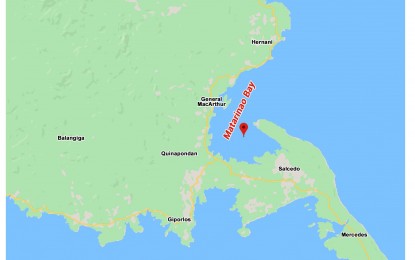
A map showing Matarinao Bay in Eastern Samar. (BFAR image)
TACLOBAN CITY – Red tide has recurred in Matarinao Bay in Eastern Samar province more than four months after it was declared toxin-free, the Bureau of Fisheries and Aquatic Resources (BFAR) reported on Monday.
The changes in weather patterns are among the factors that triggered the recurrence of the red tide phenomenon, the BFAR regional office said in a statement.
“To safeguard human lives, a local red tide warning is issued in this area as a precautionary advice to the public to refrain from gathering, selling, and eating all types of shellfishes and Acetes sp. locally known as alamang or hipon from the said bay,” BFAR said.
Matarinao Bay covers the coastal waters of the towns of General MacArthur, Hernani, Quinapondan and Salcedo in Eastern Samar.
BFAR lifted the shellfish ban in Matarinao Bay in mid-January this year.
Results of the testing conducted by the agency on shellfish samples showed that over 60 micrograms of toxins were found for every 100 grams of meat, which is beyond the regulatory limit.
Earlier, BFAR raised a red tide alert in San Pedro Bay in Samar province.
Based on the March 21 laboratory analysis, the shellfish meat sample collected from the bay in Basey town, Samar tested positive for paralytic shellfish poisoning (PSP) toxin.
Fish, squid, crab and shrimp gathered from these areas are safe to eat provided that all entrails are removed and the marine products are washed thoroughly with running water before cooking.
The BFAR asked local government units to heighten their watch against gathering, trading and consumption of shellfish to prevent the incidence of PSP which can occur minutes after ingesting bivalve shellfish (such as mussels, oysters, and clams) that contain red tide toxins.
Early PSP symptoms include tingling of the lips and tongue and may progress to tingling of fingers and toes and then loss of control of arms and legs, followed by difficulty in breathing.
Red tide is a term used to describe a phenomenon where the water is discolored by high algal biomass or a high concentration of algae. (PNA)
